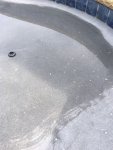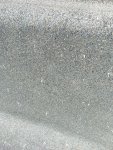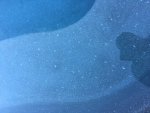As you can see, I've added more than 3 gallons of muriatic acid in one week! You'd think my pool would have a very low pH with all that acid, but I can't even keep it below a 7.5 for more than a few hours.
2-year old Luna Quartz plaster chlorine pool with rising calcium and high pH
- Thread starter aaronk
- Start date
You are using an out of date browser. It may not display this or other websites correctly.
You should upgrade or use an alternative browser.
You should upgrade or use an alternative browser.
- May 3, 2014
- 58,260
- Pool Size
- 6000
- Surface
- Fiberglass
- Chlorine
- Salt Water Generator
- SWG Type
- Pentair Intellichlor IC-40
I suspect your fill water is relatively high in TA. With evaporation, you are adding fill water.
When your pH is at 7.8, lower it to 7.2. If you continue to do that until your TA reaches 60 ppm or so, let the pH rise to 7.8 and see if it stabilizes more. You will always need to add acid when you are adding high TA fill water.
When your pH is at 7.8, lower it to 7.2. If you continue to do that until your TA reaches 60 ppm or so, let the pH rise to 7.8 and see if it stabilizes more. You will always need to add acid when you are adding high TA fill water.
I can run a TA test on my fill water, but I don't think it's necessarily high. I had to add sodium bicarb not long ago, because my TA was down around 50 (probably from all the acid I had been adding). I intentionally brought it up to 100, because I read online that a higher TA can help to stabilize pH. Perhaps this was bad info?
Even if the fill water does have high TA, I'm seeing the pH rise in a matter of hours. I can't imagine enough fill water is being added in a few hours to affect the TA and pH that drastically in such a short amount of time, but maybe.
Even if the fill water does have high TA, I'm seeing the pH rise in a matter of hours. I can't imagine enough fill water is being added in a few hours to affect the TA and pH that drastically in such a short amount of time, but maybe.
- May 3, 2014
- 58,260
- Pool Size
- 6000
- Surface
- Fiberglass
- Chlorine
- Salt Water Generator
- SWG Type
- Pentair Intellichlor IC-40
One thing to try is turning off the Ozone generator. It might be raising your pH as it does create aeration.
A lower TA will inhibit pH rise. So in your case, never raise your TA above 70 ppm or so.
Seems like you have a unique issue.
A lower TA will inhibit pH rise. So in your case, never raise your TA above 70 ppm or so.
Seems like you have a unique issue.
It has been suggested above that the plaster finish may have calcium nodules forming (as opposed to calcium scaling). And that may be the problem. If so, that could be the source of calcium increase. However, calcium scaling would cause the opposite - a lowering of the calcium level. It is also possible to have both calcium nodules and scaling at the same time. You need to determine if you have nodules or scaling for TFP to help resolve this.
Calcium "nodules" are individual and isolated raised crusty spots that can be easily scraped off. They can be spaced far apart, or very close to each other. Calcium "scaling" is like rough sandpaper, a consistent and uniform roughness). Nodules form when the plaster is suffering from shrinkage cracks, pinholes, and/or delaminations. You can literally count nodules, not so with scaling. And very small cracks are difficult to see under a small nodule.
Shrinkage cracks can be caused by excess water and excess calcium chloride added to the plaster mix. They can also be caused by not protecting (tenting) the plaster finish in hot and dry weather before it fills with water. Delamination (bond failure) can also cause cracks and pinholes to form, and then nodules will generally appear soon. The formation of nodules have nothing to do with the balance of the pool water.
Another suggestion was that the acid treatments have etched the plaster and exposed more poor quality plaster. That is also a strong possibility. Perhaps you could provide a few close-up photos of the nodules or scaling. That would help tremendously with determining this specific problem and then what to do.
Calcium "nodules" are individual and isolated raised crusty spots that can be easily scraped off. They can be spaced far apart, or very close to each other. Calcium "scaling" is like rough sandpaper, a consistent and uniform roughness). Nodules form when the plaster is suffering from shrinkage cracks, pinholes, and/or delaminations. You can literally count nodules, not so with scaling. And very small cracks are difficult to see under a small nodule.
Shrinkage cracks can be caused by excess water and excess calcium chloride added to the plaster mix. They can also be caused by not protecting (tenting) the plaster finish in hot and dry weather before it fills with water. Delamination (bond failure) can also cause cracks and pinholes to form, and then nodules will generally appear soon. The formation of nodules have nothing to do with the balance of the pool water.
Another suggestion was that the acid treatments have etched the plaster and exposed more poor quality plaster. That is also a strong possibility. Perhaps you could provide a few close-up photos of the nodules or scaling. That would help tremendously with determining this specific problem and then what to do.
Attached is a photo I took in April, a couple weeks before it was drained for the first time. I'm also attaching two pictures taken in May right after I drained the pool the first time but before they did an acid wash.
The plaster currently looks good, and there are no calcium nodules. As for scale, there's a little on the surround tile, but it's hard to tell if I have any on the plaster. As I mentioned earlier, I've been checking my chemicals almost daily to make sure it doesn't have a high LSI/CSI for any extended period of time.
The plaster currently looks good, and there are no calcium nodules. As for scale, there's a little on the surround tile, but it's hard to tell if I have any on the plaster. As I mentioned earlier, I've been checking my chemicals almost daily to make sure it doesn't have a high LSI/CSI for any extended period of time.
Attachments
It took almost two years for the nodules to start forming, but if they have nothing to do with pool chemistry, then it's highly possible the PB didn't do a proper plaster job. Is it safe to say that if chemistry was not the issue then the nodules will likely start popping up again?Shrinkage cracks can be caused by excess water and excess calcium chloride added to the plaster mix. They can also be caused by not protecting (tenting) the plaster finish in hot and dry weather before it fills with water. Delamination (bond failure) can also cause cracks and pinholes to form, and then nodules will generally appear soon. The formation of nodules have nothing to do with the balance of the pool water.
As a first-time pool owner, you can imagine my level of frustration with all of this.
Okay, the photos show definite nodules. Since this is an original plaster job on new gunite (which helps achieve a good bond), it is unlikely that major delamination or bonding failure is occurring. Instead, the plaster has small shrinkage cracking that can also cause small nodules form. It is important to note that small shrinkage cracks generally do not result in a "hollow sound" when tapped upon.
It is a 50/50 call if nodules will form again. And yes, it has nothing to do with the water balance. As Marty stated above, the calcium level can be much higher (and the CSI can be +0.5) and not result in scaling problems or issues.
The other concern I have is about the various acid treatments performed on this pool. Unless they polished the plaster after the acid wash, the plaster surface may be somewhat rough to the touch. I also believe that the many cracks, along with the acid treatments and poor plaster quality, have contributed to the calcium level increasing.
It is a 50/50 call if nodules will form again. And yes, it has nothing to do with the water balance. As Marty stated above, the calcium level can be much higher (and the CSI can be +0.5) and not result in scaling problems or issues.
The other concern I have is about the various acid treatments performed on this pool. Unless they polished the plaster after the acid wash, the plaster surface may be somewhat rough to the touch. I also believe that the many cracks, along with the acid treatments and poor plaster quality, have contributed to the calcium level increasing.
Last edited:
I should've joined this forum two years ago. I've had no less than a half dozen different pool people look at my pool when I had those nodules. Not a single one said that it was poor plaster quality; they either said "I have no idea" or "bad water chemistry."
I'm also concerned about the damage the acid treatments have caused to my plaster. As far as polishing goes, though, I'm told that Luna Quartz is a non-polished pool surface. It has always been a little rough to the touch.
Given the situation I'm in, what do I do?
I'm also concerned about the damage the acid treatments have caused to my plaster. As far as polishing goes, though, I'm told that Luna Quartz is a non-polished pool surface. It has always been a little rough to the touch.
Given the situation I'm in, what do I do?
I am sorry, I didn't realize that the plaster is an exposed aggregate (bumpy) finish. Quartz finishes are usually troweled smooth.
If it happens that more nodules appear, you may want to consider pushing for a re-plaster. I note that the pool was plastered in December and probably cold temperatures. If so, the plastering contractor may have added too much calcium chloride to the mix, in which to hardened the plaster in cold weather, but which also causes shrinkage issues.
That situation also causes excessive plaster dust to form after filling the newly plastered pool. If you decide to follow through on that, the plaster can be analyzed for its' calcium chloride content and could be used as evidence that too much was added. That would be a basis to insist that they take responsibility. This is all unfortunate for you, and I am sure, disappointing. I wish there was a more positive solution for this situation. Hopefully, no further nodules will form, and won't need anymore acid treatments which are detrimental to begin with.
If it happens that more nodules appear, you may want to consider pushing for a re-plaster. I note that the pool was plastered in December and probably cold temperatures. If so, the plastering contractor may have added too much calcium chloride to the mix, in which to hardened the plaster in cold weather, but which also causes shrinkage issues.
That situation also causes excessive plaster dust to form after filling the newly plastered pool. If you decide to follow through on that, the plaster can be analyzed for its' calcium chloride content and could be used as evidence that too much was added. That would be a basis to insist that they take responsibility. This is all unfortunate for you, and I am sure, disappointing. I wish there was a more positive solution for this situation. Hopefully, no further nodules will form, and won't need anymore acid treatments which are detrimental to begin with.
I appreciate all the advice and feedback. I don't have a plaster sample from when it was first built, so I may need to find another angle if I decide to go after the PB for a bad plaster job.
An existing chunk of plaster could be removed from under the main drain cover as a first sample and use that to get an idea of how much was added.
Well, since I wrote that in August, my CH is up to 400 with the Luna Quartz plaster. So I wonder what's going on. My fill water CH is only 50, so that's not the source. I have not added any chemicals with calcium in them.I also have Luna Quartz. I also have high CH at 370. But it’s stable so I don’t care.
I would leave it alone and see whether it stabilizes. If it does, relax. If it continues to rise forever, you have cause for concern.
@aaronk , did you ever resolve your CH issue? How does the story end?
I wish I could say that there is a happy ending to report, but unfortunately, I'm still dealing with rising CH and pH. I haven't checked CH in a couple weeks, but when I last checked, it was at a 410. This is up from 310 in mid-August, and I also have not added any chemicals that have calcium (switched to using liquid chlorine). Given that our tap water is only 160 CH, I can't imagine this would cause my pool CH to rise by 100 ppm within two months. Surely we've had some evaporation, but not enough to cause that kind of a jump in such a short time.Well, since I wrote that in August, my CH is up to 400 with the Luna Quartz plaster. So I wonder what's going on. My fill water CH is only 50, so that's not the source. I have not added any chemicals with calcium in them.
@aaronk , did you ever resolve your CH issue? How does the story end?
Thread Status
Hello , This thread has been inactive for over 60 days. New postings here are unlikely to be seen or responded to by other members. For better visibility, consider Starting A New Thread.




